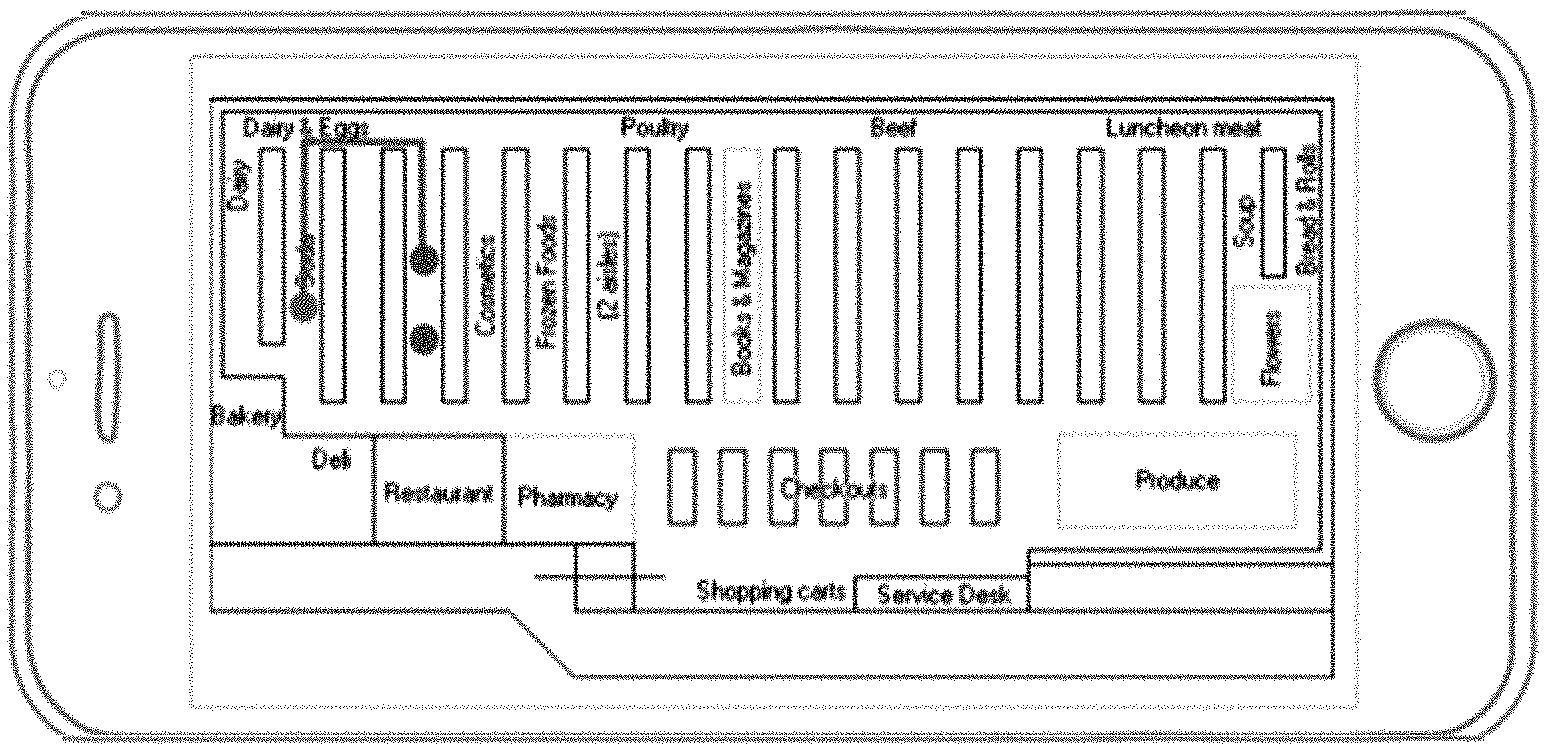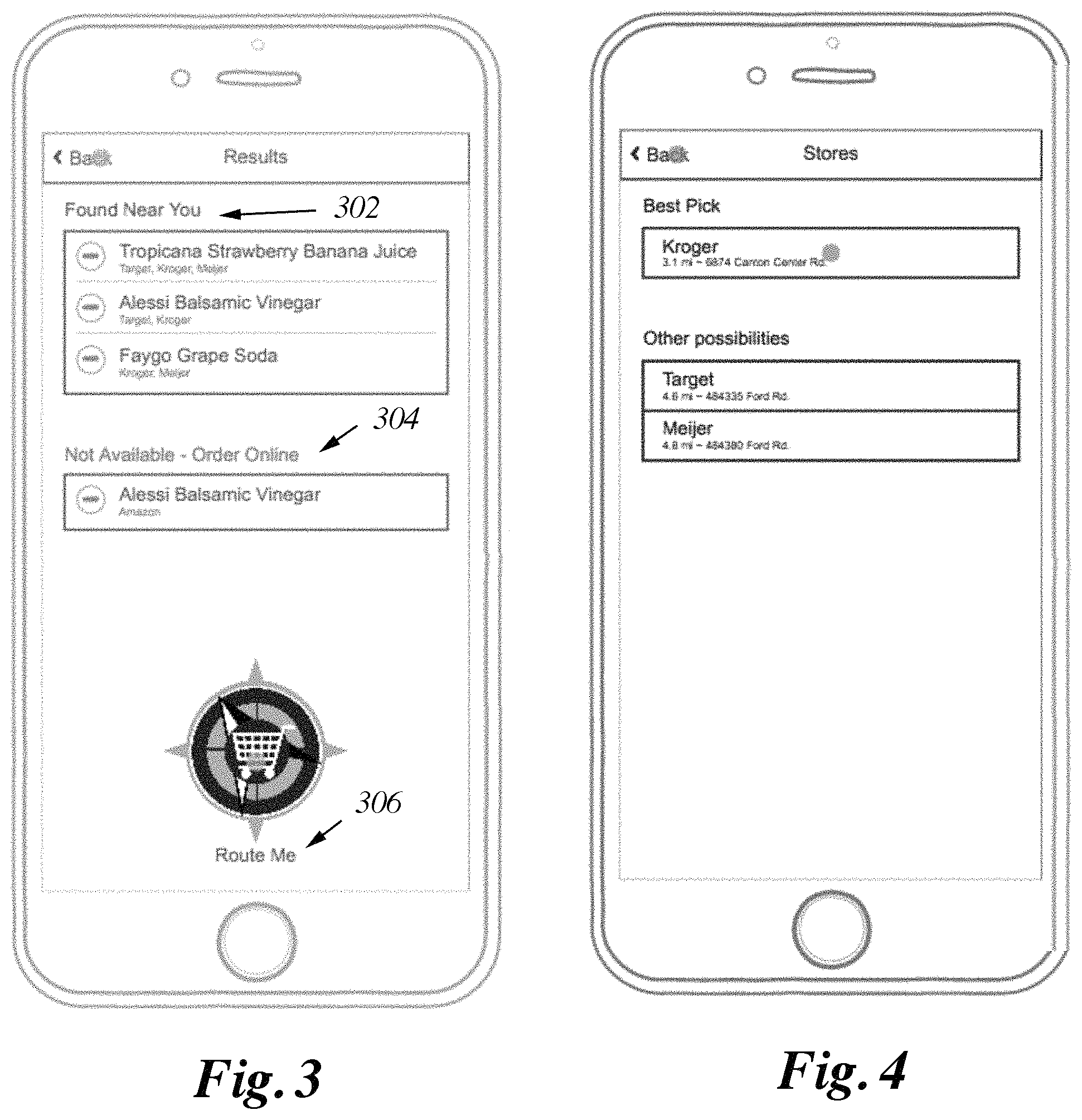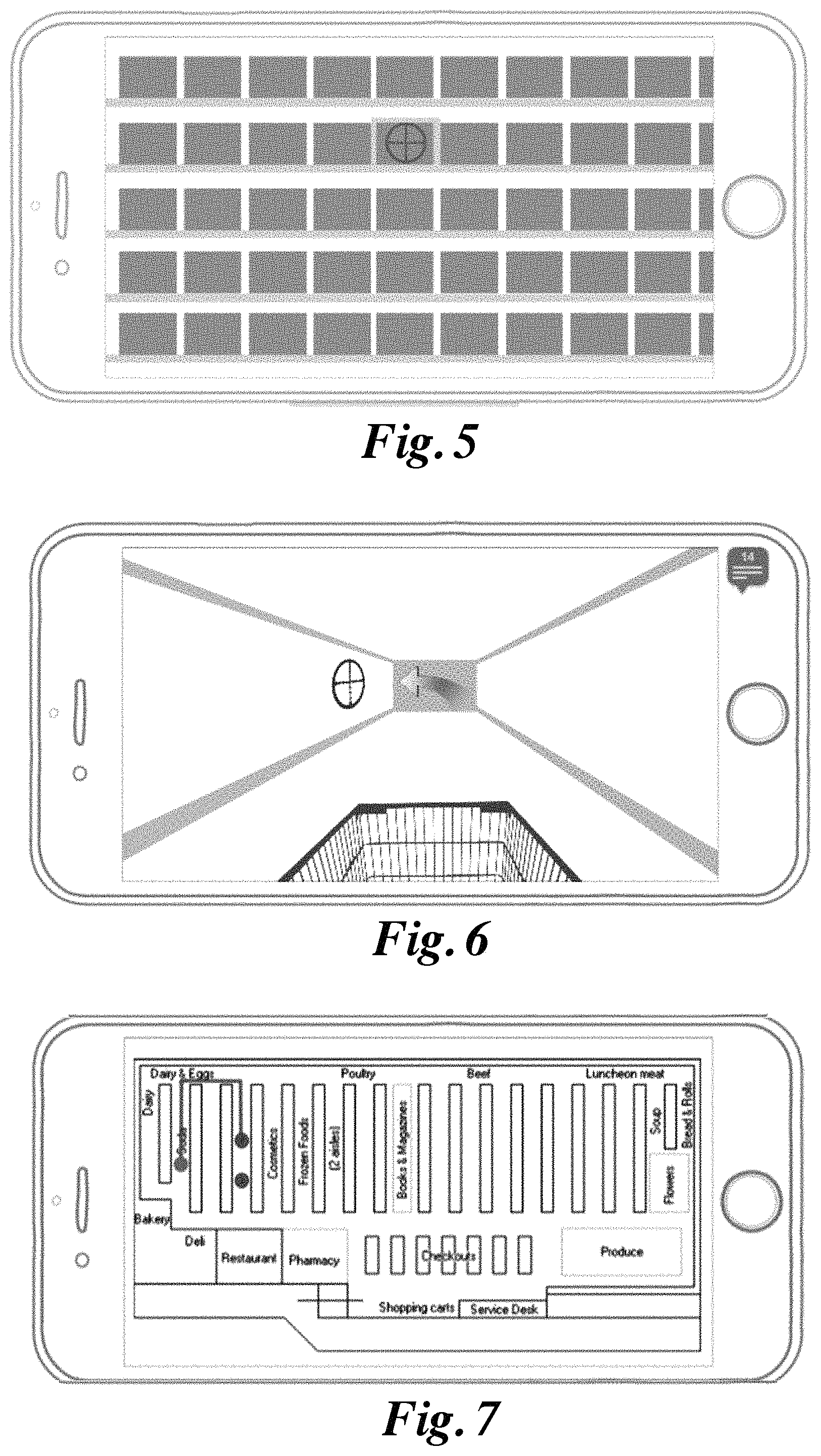System and method for locating in-store products
Kaufman
U.S. patent number 10,679,275 [Application Number 15/680,630] was granted by the patent office on 2020-06-09 for system and method for locating in-store products. The grantee listed for this patent is Jacob Kaufman. Invention is credited to Jacob Kaufman.




| United States Patent | 10,679,275 |
| Kaufman | June 9, 2020 |
System and method for locating in-store products
Abstract
A mobile application ("app") enabling a shopper to identify an item or items that the user wishes to locate or purchase. The device displays a list of stores which stock the item(s), and a user is then provided with in-store guidance enabling the shopper to find the item or items that the user wishes to locate or purchase. A user can identify an item or items by scanning a product bar code, scanning a product label; capturing an image of a product, or typing a product name in a search field. The method further includes identifying stores that stock the item. Items can be added to an accumulative shopping list, and items may be ordered online if not available nearby. The system provides basic navigation to store(s) carrying the item(s). Once at a store, an interior route to a product is portrayed through an overhead view map of a store layout. Once near a product, a user may be shown a virtual display of a shelf with the vertical or height placement of the product on the nearby shelf.
| Inventors: | Kaufman; Jacob (West Bloomfield, MI) | ||||||||||
|---|---|---|---|---|---|---|---|---|---|---|---|
| Applicant: |
|
||||||||||
| Family ID: | 61190789 | ||||||||||
| Appl. No.: | 15/680,630 | ||||||||||
| Filed: | August 18, 2017 |
Prior Publication Data
| Document Identifier | Publication Date | |
|---|---|---|
| US 20180053232 A1 | Feb 22, 2018 | |
Related U.S. Patent Documents
| Application Number | Filing Date | Patent Number | Issue Date | ||
|---|---|---|---|---|---|
| 62376999 | Aug 19, 2016 | ||||
| Current U.S. Class: | 1/1 |
| Current CPC Class: | G06Q 30/0633 (20130101); G06Q 30/0623 (20130101); G06K 7/1413 (20130101) |
| Current International Class: | G06Q 30/06 (20120101); G06K 7/14 (20060101) |
| Field of Search: | ;705/26.1,26.8,26.61 |
References Cited [Referenced By]
U.S. Patent Documents
| 2008/0043013 | February 2008 | Gruttadauria |
| 2012/0214515 | August 2012 | Davis |
| 2013/0160104 | June 2013 | Carlson |
| 2013/0317950 | November 2013 | Abraham |
| 2016/0223339 | August 2016 | Pellow |
| 2017/0124511 | May 2017 | Mueller |
| 2018/0005035 | January 2018 | Bogolea |
Attorney, Agent or Firm: Posa; John G. Belzer PC
Parent Case Text
REFERENCE TO RELATED APPLICATIONS
This Application claims priority to U.S. Provisional Patent Application Ser. No. 62/376,999, filed Aug. 19, 2016, the entire content of which is incorporated herein by reference.
Claims
The invention claimed is:
1. A method of locating in-store products, comprising the steps of: providing a plurality of bar-coded products for sale and a plurality of bar-coded shelf areas within a store, and wherein the store maintains an inventory of the bar-coded products; generating a virtual three-dimensional layout of the store, the layout including the location of the shelves within the store and the vertical or height placement of products on the shelves; using a bar-code scanning device to scan the bar-coded products into the store's inventory; using a bar-code scanning device to scan bar-coded shelf areas to determine the placement of the scanned products on the shelves; updating the placement of the scanned products on the virtual shelves in the virtual three-dimensional layout of the store; providing a portable electronic device with application software enabling a user to perform the following functions: identifying a product that the user wishes to locate or purchase; displaying a list of stores which stock the product; providing the user with in-store guidance enabling the user to find the product that the user wishes to locate or purchase; and wherein the in-store guidance includes displaying, on the portable electronic device in accordance with the virtual three-dimensional layout of a store, an overhead view map of the store layout and a shelf showing the vertical or height placement of the product on the shelf.
2. The method of claim 1, wherein the user can identify a product that the user wishes to locate or purchase by scanning a product bar code using the portable electronic device.
3. The method of claim 1, further including the steps of: identifying stores that stock the product; and ordering the product online if the product is not available when identifying stores that stock the product.
4. The method of claim 1, further including the step of providing navigation to a store that stocks the product.
5. The method of claim 1 wherein, once at a store, the method includes the step of showing an interior route to a product is through an overhead view map of a store layout.
6. The method of claim 1 wherein, if the user has created a shopping list of items, the method includes the step of directing the customer to an item on the list.
7. The method of claim 1, further including the steps of: providing a database including a product inventory for the store; and synchronizing the store's inventory with the tracking of shelf placement locations.
8. The method of claim 1, wherein the user can identify a product that the user wishes to locate or purchase by scanning a product label or capturing an image of a product using the portable electronic device.
9. The method of claim 1, wherein the user can identify a product that the user wishes to locate or purchase by typing a product name in a search field using the portable electronic device.
10. The method of claim 1, wherein: the shelves have grid placement areas with sizes; and the grid sizes are adjustable to accommodate the placement of products having different sizes.
11. The method of claim 10, including the step of editing the grid sizes with respect to the number of vertical shelves, horizontal shelf length, vertical shelf height, or display angle.
12. The method of claim 10, shelving grid placement areas are barcode specific.
13. The method of claim 1, wherein the bar-code scanning device is a store's existing laser scanner.
14. The method of claim 1, wherein the bar-code scanning device is a smartphone.
15. The method of claim 1, wherein the portable electronic device is a smartphone.
Description
FIELD OF THE INVENTION
This invention resides in a mobile application that directs customers to a specific shelf location to find a desired item without the need for 3D scanning or geo-locating technologies.
BACKGROUND OF THE INVENTION
Unfortunately shopping can be a frustrating, unpleasant experience. Due to the plethora of competing products and the number of stores which might carry them, finding the right store(s) at the right price(s) can be challenging.
The current industry standard for retail stores is to place items based on bar-code UPC label on a shelf location, which also has a bar-code UPC label. For standard inventory tracking, each item is associated with a specific shelf placement. However, this system does not provide consumers with direct assistance, who just want to find what they are looking for.
Clearly any device or method that can assist shoppers would be of benefit to consumers.
SUMMARY OF THE INVENTION
This invention assists shoppers by providing a device and method of locating in-store products. The preferred embodiment resides in a portable electronic device with application software enabling a user to identify an item or items that the user wishes to locate or purchase. The device displays a list of stores which stock the item(s), and a user is then provided with in-store guidance enabling the shopper to find the item or items that the user wishes to locate or purchase.
A user can identify an item or items by scanning a product bar code, scanning a product label; capturing an image of a product, or typing a product name in a search field. The method further includes identifying stores that stock the item. Items can be added to an accumulative shopping list, and items may be ordered online if not available nearby.
The system provides basic navigation to store(s) carrying the item(s). Once at a store, an interior route to a product is portrayed through an overhead view map of a store layout. Once near a product, a user may be shown a virtual display of a shelf with the vertical or height placement of the product on the nearby shelf. If the customer has created a shopping list of items, the customer may be directed to the next nearest item on the list.
A store's layout may be created with 3D software once a store has created an online account, with the system and method further including the step of synchronizing the store's inventory with the online account for tracking of shelf placement locations.
BRIEF DESCRIPTION OF THE DRAWINGS
FIG. 1 depicts the options available to a user for searching goods;
FIG. 2 illustrates a typical scanning process;
FIG. 3 depicts the results of a search;
FIG. 4 shows how the application also provides best picks/sorting based upon various criteria, such as proximity, price, sales, discounts, etc.;
FIG. 5 illustrates how, once at the store, the interior route to a product is displayed via overhead view map of store layout;
FIG. 6 depicts how, once near a product, the customer will be shown a virtual display of the shelf with the vertical or height placement of the product on the nearby shelf; and
FIG. 7 shows how, once the customer has created a shopping list of items, they are directed to the next nearest item on the list.
DETAILED DESCRIPTION OF THE PREFERRED EMBODIMENTS
This invention resides in a mobile application that directs customers to a specific shelf location to find a desired item without the need for 3D scanning or geo-locating technologies. The solution integrates a retail location's existing shelving placement inventory system with an overall layout of the store's floor plan. The system and method, referred to herein as "StoreTrek," follows a device user within this layout and directs customers to a specific shelf location to find an item. This process is accomplished without any need for iBeacons, 3D scanning, or GPS technologies. Once a store layout is configured with a store manager, the software synchronizes with the layout database and coordinates with a hand-held device location to report product locations to the users.
The invention is preferably implemented as a software application ("app") used by customers to find products within a store via a virtual map of a store's interior. This is carried out by both encompassing an overhead overall layout as well as a horizontal shelf-by-shelf layout to vertically locate products within a particular height of a shelf placement.
StoreTrek is also used by store managers and/or stock managers to place and track inventory on shelves. Stores can use the software to place products within a specific grid vertically and horizontally on a virtual version of their store shelves.
The invention accomplishes these processes by utilizing the store's existing bar code stock systems and creating a virtual 3D layout version of the entire store that can be edited by store managers, even if shelves are moved or re-arranged at any time.
StoreTrek is to be offered to customers for free with advertisements included in the interface. Advertisements will offset the cost of development and operating expenses. A paid "pro" version will be offered for those customers who do not want to be bothered by advertisements. It is anticipated that store manager versions of the StoreTrek system will be "pro" versions and are included with a store's subscription account to the StoreTrek service and part of creating their virtual store account and inventory system.
There are three primary functions implemented by the StoreTrek system. First, a user identifies an item or items they wish to locate/purchase. Second, stores are presented that stock the identified item(s), and third, the user is provided in-store guidance to find the actual item or items they are looking for. Each one of these functions includes sub-functions to streamline the process overall.
For example, after opening the StoreTrek app, a user can search for products by: Scanning the product bar code; Scanning the product label; Scanning the entire product itself; or Typing the product name in a search field.
FIG. 1 illustrates these options. Opening the application initiates three primary actions: (1) Launching of the device scanner and camera verified with windows such as window 102 for the scanner; (2) Providing a search field 104; and (3) Showing a listing of Recent Items enabling a user to replace items with new ones. Selecting a PLUS icon automatically adds the newly identified product to the list. Regardless of the search approach used, it is anticipated that a search will be conducted via an Internet connection prompted by the app to match the user input with a specific product. For example, if a product name is entered incorrectly in the search field, corrected results will be presented for clarification.
FIG. 2 illustrates a typical scanning process. Area 202 shows the scanning process, with touch areas 204, 206 being used for DONE and CANCEL functions, respectively. Note that the label and products scans are nearly identical, except that area 202 shows the product or label being captured. Results of the search are shown as follows: Nearby stores with product are shown Products can be added to an accumulative shopping list Ordered online if not available nearby
FIG. 3 depicts the results of search. As can be seen, the app found various locations where three items 302 may be purchased, as well as an on-line option for an item 304 that could not be located nearby. After items are added to the Results list, the app automatically determines which nearby stores have the items in-stock. A Route Me action 306 acts upon the items in the Results list. Items not available are offered suggestions to affiliate locations such as Amazon (allowing further monetization).
As shown in FIG. 4, the app will also provide best picks/sorting based upon various criteria, such as proximity, price, sales, discounts, etc., enabling a user to select a desired store. As part of a purchasing decision, if a user selects "Route Me," various actions will be taken: Basic navigation to the store is an option available Once at the store, the interior route to a product is show via overhead view map of store layout (FIG. 5); Once near a product the customer will be shown a virtual display (FIG. 6) of the shelf with the vertical or height placement of the product on the nearby shelf; and If the customer has created a shopping list of items, they are then directed to the next nearest item on the list (FIG. 7). Store Manager Experience:
A store's layout is created with 3D software once a store has created their online account and their inventory system is synchronized with this account for tracking of shelf placement locations. Store managers orientate shelving units, end-cap shelves and various furniture objects to the proper orientation of their location in the real store. All shelving units have grid sizes that are adjustable for various size product placements and can be edited for number of vertical shelves, horizontal length, vertical height and display angles. All shelving grid placement areas are barcode specific and database registered with a store's account so they can be assigned a product Store managers scan products into inventory as they normally would and subsequently scan a shelves bar code area for its placement--meanwhile, their StoreTrek account database is updated to synchronize the product placement into inventory with the shelf's placement. Store managers can use the StoreTrek app via a mobile device to scan products into inventory or they can use their existing bar code inventory scanners. As an added benefit of using StoreTrek, our app will update to show them the product placement on the virtual shelf whereas their existing system will not. Store managers can edit their layout, shelf placement and furniture displays at any time in the online account. StoreTrek online account subscriptions can be fully integrated into a retailer's online presence, website and online store. Product delivery services can easily take advantage of StoreTrek and retailers can integrate shopping services experiences for the "stay-at-home" shopper to shop for products virtually and then have everything delivered to their home.
Other options include mobile device location tracking within the store interior as well as integration with a store's wireless system for instant sales, marketing and other various retail applications. Ultimately the StoreTrek app will provide a full augmented-reality shopping experience while also benefiting stores with a state-of-the art inventory shelf placement tracking system that is both easy to use and can be utilized from any mobile device.
* * * * *
D00000

D00001

D00002

D00003

XML
uspto.report is an independent third-party trademark research tool that is not affiliated, endorsed, or sponsored by the United States Patent and Trademark Office (USPTO) or any other governmental organization. The information provided by uspto.report is based on publicly available data at the time of writing and is intended for informational purposes only.
While we strive to provide accurate and up-to-date information, we do not guarantee the accuracy, completeness, reliability, or suitability of the information displayed on this site. The use of this site is at your own risk. Any reliance you place on such information is therefore strictly at your own risk.
All official trademark data, including owner information, should be verified by visiting the official USPTO website at www.uspto.gov. This site is not intended to replace professional legal advice and should not be used as a substitute for consulting with a legal professional who is knowledgeable about trademark law.